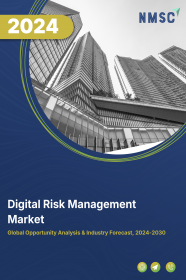
Digital Risk Management Market by Component (Software and Service), by Deployment (Cloud and On-Premise), by Solution (Integrated Digital Risk Protection Platforms and Digital Risk Protection Services), by Enterprise Size (SMEs and Large Enterprises), and by Industry Vertical (IT & Telecom, BFSI, Automotive, Healthcare, Manufacturing, Government, and Education)– Global Opportunity Analysis and Industry Forecast 2024-2030
Digital Risk Management Market Overview
The global Digital Risk Management Market size was valued at USD 9.08 billion in 2023 and is predicted to reach USD 25.01 billion by 2030 with a CAGR of 15.6% from 2024-2030. The market for digital risk management refers to the sector focused on identifying, assessing, and mitigating risks associated with digital operations and technologies within businesses.
This market includes a range of services and solutions designed to protect enterprises form cyber threats, data breaches, operational disruptions, and compliance issues arising from their digital infrastructure. It includes tools and services for risk assessment, cybersecurity, data protection, incident response, and regulatory compliance.
Digital risk management provide safety to digital assets, ensuring business continuity, and maintain regulatory compliance in increasingly digital and interconnected business environment.
Market Dynamics and Trends
The digital risk management market demand is increasing due to the rising frequency of sophisticated cyberattacks such as ransomware, phishing, and data breaches. A report by Federal Trade Commission in February 2022 shows that consumers reported losing more than USD 5.8 billion to cyber frauds in 2021.
This surge in the number of cyber threats is creating an urgent need for robust data security solutions including digital risk management solutions. These solution helps to detect, prevent, and respond to cyber threats, ensuring that businesses to protect their data, comply with regulations, and maintain trust with customers.
Additionally, rising digital transformation with the adoption of advanced technologies such as cloud computing, IoT and artificial intelligence (AI) is further driving the growth of the market. As per a survey conducted by Gartner, in North America and Europe around 39% enterprises adopted industry cloud solutions and it is estimated more 17% enterprises to adopt industry cloud solutions by the end of 2026.
This expansion raises the number of potential security threats and complicates risk management. To effectively tackle these new challenges and protect consumer information, organizations are adopting advanced digital risk management solutions to address emerging vulnerabilities and secure their digital assets.
However, the high costs associated with setting up and maintaining a robust digital risk management system, including software licenses, employee training, and hiring cybersecurity professionals, is restraining the digital risk management market expansion. On the other hand, the integration of AI-powered threat detection and response in cyber risk management is expected to create lucrative growth opportunities by enhancing the ability to identify and mitigate threats in real-time.
AI technologies can analyze vast amounts of data quickly, detecting anomalies and predicting potential security breaches more accurately than traditional methods. This leads to more effective and efficient risk management, attracting businesses seeking advanced solutions to safeguard their digital assets, and ultimately driving the digital risk management market growth.
Market Segmentation and Scope of Study
The global digital risk management market report is segmented on the basis of component, deployment, solution, enterprise size, industry vertical and region. Based on component, the market is classified into software and service. Based on the deployment, the market is segmented into cloud and on-premise. On the basis of solution, the market is categorized into integrated digital risk protection platforms and digital risk protection services. On the basis of enterprise size, the market is divided into SMEs and large enterprises. On the basis of industry vertical, the market in categorized into IT & telecom, BFSI, automotive, healthcare, manufacturing, government, education. Regional breakdown and analysis of each of the aforesaid classifications include regions comprising of North America, Europe, Asia-Pacific, and RoW.
Geographical Analysis
North America dominates the global digital risk management market share and is potently expected to remain dominant in the market throughout the forecast period. This is attributed to the rising number of data breaches and cyberattacks in the region, leading to a heightened awareness and demand for secure and reliable digital risk management solutions.
According to a report published by the Federal Trade Commission in February 2022, consumers reported losses exceeding USD 5.8 billion due to online frauds in 2021. Consequently, the surge in the number of data thefts and breaches is rising the need for robust data security solutions, accelerating the market growth.
Moreover, the presence of key market players such as Microsoft corporation and Cisco Systems, Inc. that are adopting strategies including product launch is further driving the digital risk management market growth.
For instance, in June 2023, Microsoft and Moody’s launched enhanced risk data analytics solutions leveraging generative AI. The collaboration aimed to improve risk management by providing businesses with advanced tools for analysing and interpreting complex risk data.
These solutions integrated AI technologies to enhance predictive analytics, streamline data processing, and offer more accurate risk assessments. These market players are taking proactive steps to advance digital threat landscape by introducing innovative technologies and solutions, thereby driving growth and setting new standards for risk assessment and management in the industry.
On the other hand, the Asia-Pacific region is experiencing substantial growth in the global digital risk management market. This is due to the increasing use of e-commerce platforms, that drives the need for secure and reliable digital risk management solutions to protect consumer data.
A report published by McKinsey & Company projects that the Southeast Asian e-commerce market will triple at a compound annual growth rate of 22%, reaching around USD 230 billion in gross merchandise volume between 2024 and 2026. This rapid growth in the e-commerce sector highlights the need for advanced digital risk management solutions to safeguard consumer data, a significantly boosting the market expansion.
Furthermore, the market for digital risk management is rising significantly in the Asia-Pacific region due to the increasing adoption of mobile devices, particularly smartphones. According to the Indian Ministry of Information and Broadcasting, the number of mobile users in India reached 1.2 billion in 2022. This growing demand for robust data security and management solutions to protect personal and sensitive information stored on mobile devices is significantly driving market growth.
Competitive Landscape
Various market players operating in the digital risk management industry include Microsoft Corporation, Cisco Systems, Inc., Broadcom Inc., Palo Alto Networks, Inc., Kaspersky Lab, Rapid7, Inc., Proofpoint, Inc., Trend Micro Inc., Fortinet, Inc., RSA Security LLC, CyberArk Software Ltd., CrowdStrike Holdings, Inc., Darktrace plc, Forcepoint LLC, Digital Shadows Ltd, and others. These companies are adopting strategies such as product launches to maintain their dominance in the global digital risk management sector.
For instance, in June 2024, Broadcom launched new cybersecurity solutions, featuring advanced threat detection and response technologies designed to bolster digital risk management.
The new offerings included cutting-edge security solutions such as AI-powered threat intelligence and automated incident response systems. These technologies were aimed at enhancing the ability of businesses to identify, analyse, and mitigate emerging cyber threats in real-time.
Also, in June 2023, Cisco launched next-generation solutions designed to enhance both security and productivity through the use of generative AI. The new offerings included advanced AI-driven security tools aimed at improving threat detection and response, as well as solutions to optimize risk management processes. These innovations provided businesses with more robust and adaptive security measures, enhancing their ability to manage digital risks effectively.
Key Benefits
-
The report provides quantitative analysis and estimations of the digital risk management market from 2024 to 2030, which assists in identifying the prevailing industry opportunities.
-
The study comprises a deep-dive analysis of the current and future digital risk management market trends to depict prevalent investment pockets in the market.
-
Information related to key drivers, restraints, and opportunities and their impact on the market is provided in the report.
-
Competitive analysis of the players, along with their market share is provided in the report.
-
Value chain analysis in the market study provides a clear picture of roles of stakeholders.
Digital Risk Management Market Key Segments
By Component
-
Software
-
Service
By Deployment
-
Cloud
-
On-Premise
By Solution
-
Integrated Digital Risk Protection Platforms
-
Digital Risk Protection Services
By Enterprise Size
-
SMEs
-
Large Enterprises
By Industry Vertical
-
IT & Telecom
-
BFSI
-
Automotive
-
Healthcare
-
Manufacturing
-
Government
-
Education
By Region
-
North America
-
The U.S.
-
Canada
-
Mexico
-
-
Europe
-
The UK
-
Germany
-
France
-
Italy
-
Spain
-
Denmark
-
Netherlands
-
Finland
-
Sweden
-
Norway
-
Russia
-
Rest of Europe
-
-
Asia-Pacific
-
China
-
Japan
-
India
-
South Korea
-
Australia
-
Indonesia
-
Singapore
-
Taiwan
-
Thailand
-
Rest of Asia-Pacific
-
-
RoW
-
Latin America
-
Middle East
-
Africa
-
REPORT SCOPE AND SEGMENTATION:
|
Parameters |
Details |
|
Market Size in 2023 |
USD 9.08 Billion |
|
Revenue Forecast in 2030 |
USD 25.01 Billion |
|
Growth Rate |
15.6% from 2024 to 2030 |
|
Analysis Period |
2023–2030 |
|
Base Year Considered |
2023 |
|
Forecast Period |
2024–2030 |
|
Market Size Estimation |
Billion (USD) |
|
Growth Factors |
|
|
Countries Covered |
28 |
|
Companies Profiled |
15 |
|
Market Share |
Available for 10 companies |
|
Customization Scope |
Free customization (equivalent to up to 80 working hours of analysts) after purchase. Addition or alteration to country, regional, and segment scope. |
|
Pricing and Purchase Options |
Avail customized purchase options to meet your exact research needs. |
KEY PLAYERS
-
Microsoft Corporation
-
Cisco Systems, Inc.
-
Broadcom Inc.
-
Palo Alto Networks, Inc.
-
Kaspersky Lab
-
Rapid7, Inc.
-
Proofpoint, Inc.
-
Trend Micro Inc.
-
Fortinet, Inc.
-
RSA Security LLC
-
CyberArk Software Ltd.
-
CrowdStrike Holdings, Inc.
-
Darktrace plc
-
Forcepoint LLC
-
Digital Shadows Ltd.

















 Speak to Our Analyst
Speak to Our Analyst





















